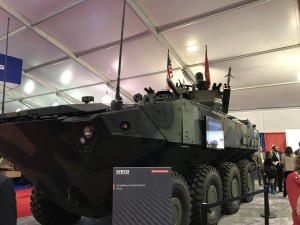The Navy’s top acquisition official said the Marine Corps’ new Amphibious Combat Vehicle (ACV) program is on track and he was pleased with its performance.
BAE Systems is currently producing the ACV under low-rate initial production (LRIP) contracts. The company received its latest LRIP for 26 more vehicles in February, raising the total up to 116 vehicles (Defense Daily, Feb. 26).

The Marine Corps said it is going with a family of vehicles approach for the ACV and plans to have four variants: a personnel carrier variant to carry 13 Marines and transport them from ship to shore for land operations, a turreted version (ACV-130), a command and control platform (ACV-C), and a recovery variant (ACV-R).
Last year, John Swift, BAE’s director of amphibious programs, said the Initial Operational Test and Evaluation (IOT&E) for the base personnel model ACVs was to start in the third quarter of FY ’20, with a full-rate production decision planned for the fourth quarter of FY ’20 (Defense Daily, June 25, 2019).
Assistant Secretary of the Navy for Research, Development and Acquisition James Geurts confirmed to reporters during a press call Tuesday ACV recently completed the IOT&E.
“We are continuing at the planned production rates at BAE and we’re coming up on a fielding decision followed by a full rate production decision. So that program is tracking well and pleased with its performance and cost schedule performance,” he said after speaking at the virtual 2020 Modern Day Marine Exposition.
Separately during an event panel, John Garner, Program Executive Officer for Land Systems, said ACV finished its IOT&E on Sept. 4.
“We’re pending a full-rate production decision in the November timeframe. We’re already in LRIP. And we’re going to start actually fielding the ACV here in the next month, with an early fielding,” Garner said.
He specified the fielding is just for the initial personnel variant.
“In the future, over the next five to six years, we’re going to be developing a command and control variant, a 30mm gun variant and a recovery variant,” he added.
Geurts added that while in California for a visit to see various Navy and Marine Corps systems, industry, and new projects, Secretary of Defense Mark Esper got a look at ACV.
“That to me has been a program that’s executing well with a good plan going forward,” Geurts added.
In contrast, Geurts said he is not tracking any major efforts on other new connectors aside from ACV and aircraft.
“At my level I’m not tracking any, I would say, specific other than I’m always encouraging folks to look for novel and new ways that we might accomplish a mission to make sure we’ve got all those ideas on the table.”